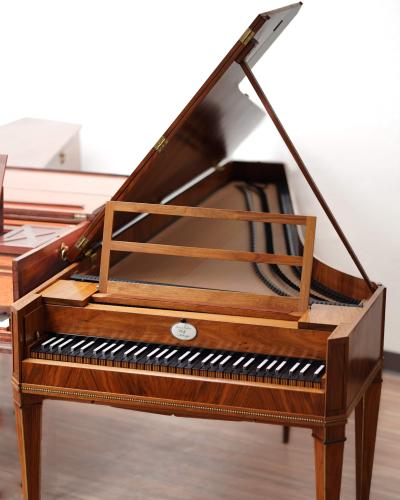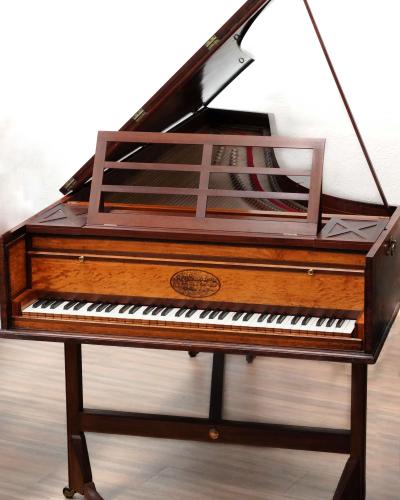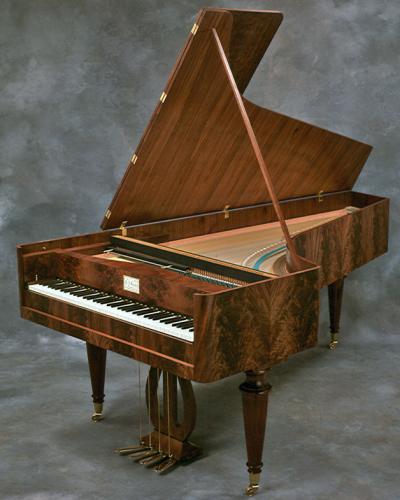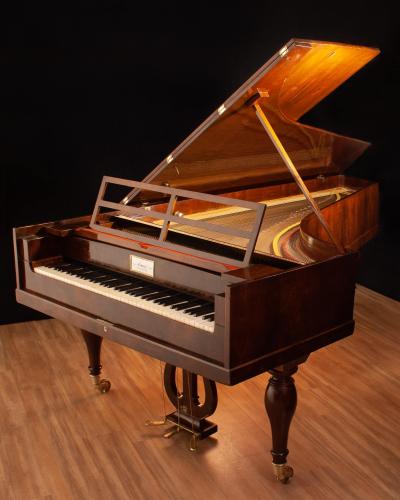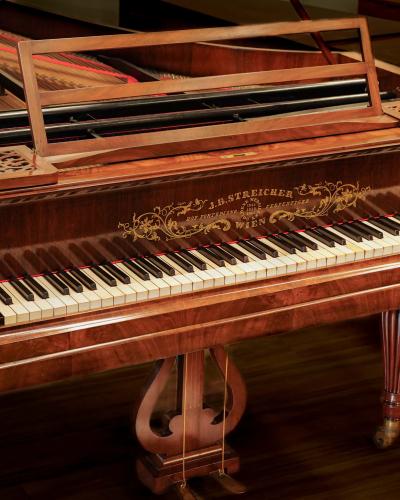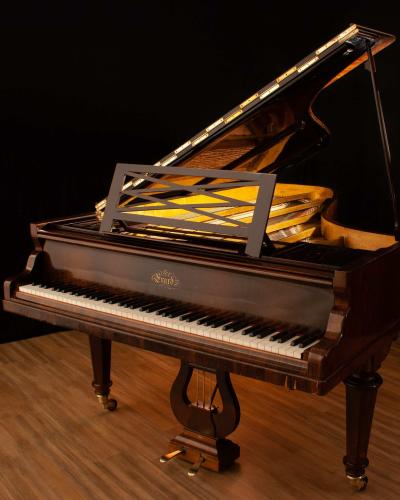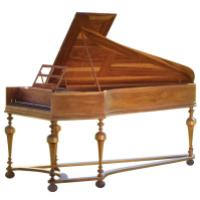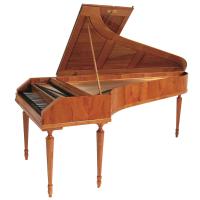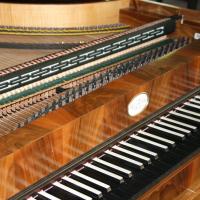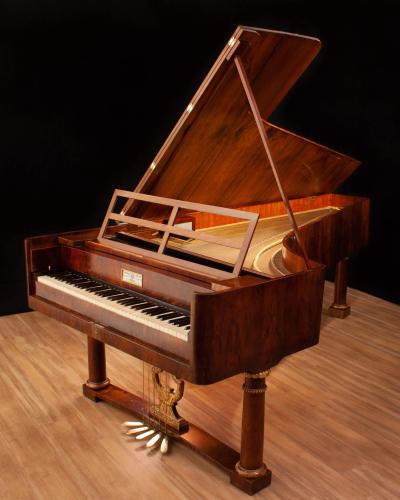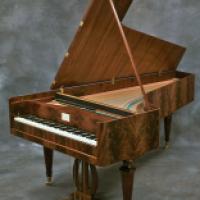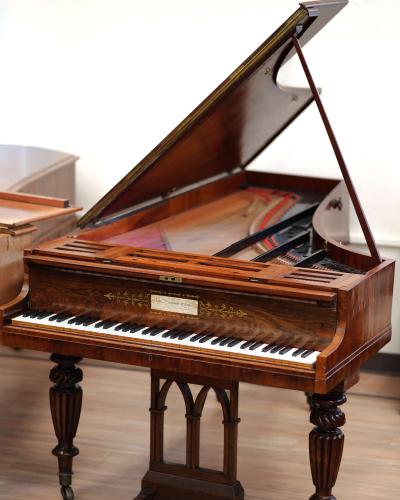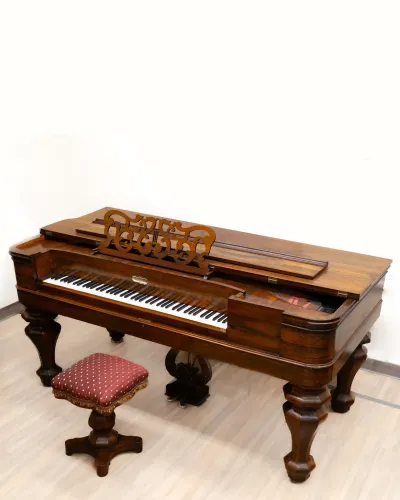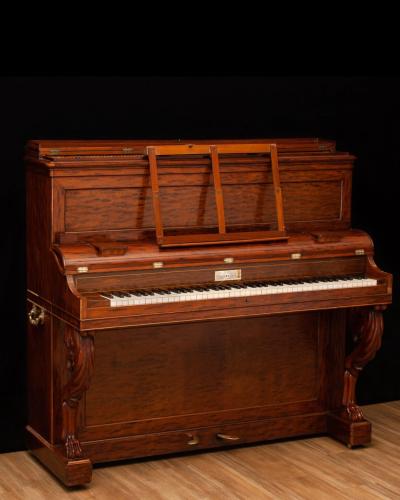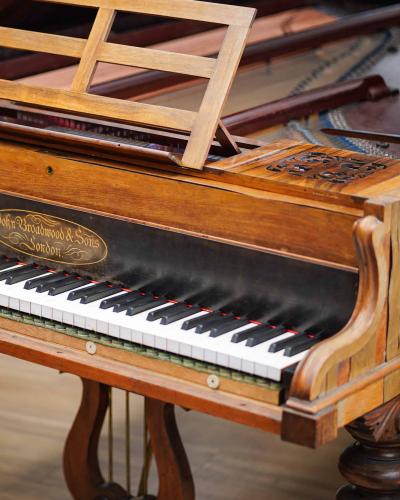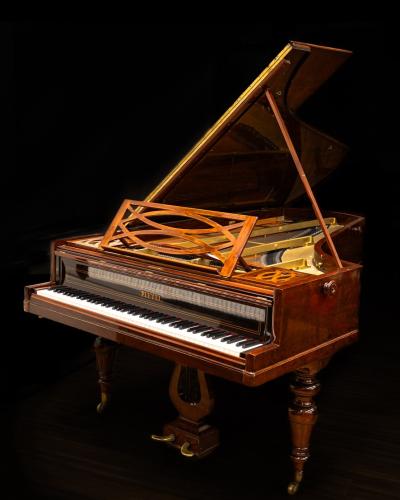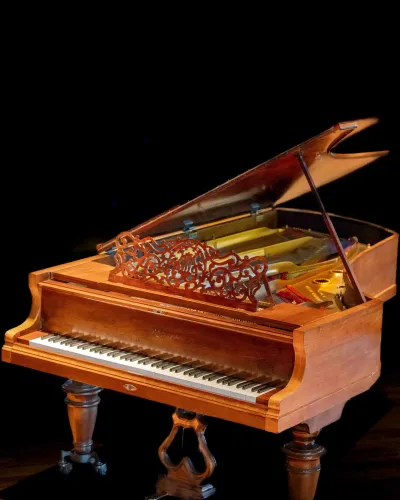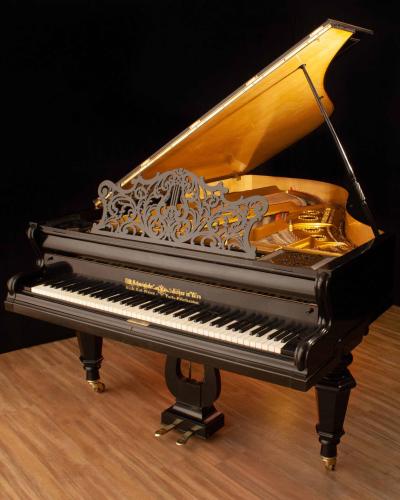The expertly curated piano collection represents some of the best exemplars—originals and replicas—associated with major composers for the piano from the 18th through 20th centuries. The collection features all of the important historical and modern schools of piano building, as well as modern master-builders from Europe and North America. Pianos are regulated to be concert-ready and routinely tuned to support the Center’s performance, research, and educational programs. Select instruments (including some originals) may be made available for loan to institutional partners and specialized research or performance projects.
Highlights
Piano after Gottfried Silbermann, Saxony, 1749
Piano after Andreas Stein, Augsburg, 1784
John Broadwood & Sons, London, 1799
Gift of Nancy Garrett
5 1/2 Octaves
There were two very distinct types of fortepiano in the late eighteenth century: the English and the so-called Viennese. Today many builders make Stein and Walter copies, and for many the term “fortepiano” refers to such instruments. The difference between the Viennese and English instruments is wonderfully described by Hummel: while the Viennese instrument, with its light and ultra fast mechanism speaks clearly and promptly in every register, the English instrument, with its deeper touch and “fuller” sound, must also be given its due. Playing first on this instrument and subsequently on the Schantz fortepiano will make this distinction eminently clear.
Sound example: Chopin Waltz performed by M. Bilson
Piano after Johann Schantz, Vienna, c. 1800
Copy by Thomas and Barbara Wolf, 1991
Gift of Malcolm Bilson
5 Octaves and Two Notes
Johann Schantz (1762–1828) was born in Bohemia (now the Czech Republic). He established a workshop with his brother Wenzel outside Vienna in the 1780s. Their first instruments were unsigned. After Wenzel’s death in 1791, Johann became a member of the instrument makers’ guild and the workshop began producing signed instruments.
In Vienna around 1800 there were more than 100 fortepiano builders. The most famous was Anton Walter (Mozart’s instrument was a Walter). Schantz, however, built excellent instruments as well, praised by both Haydn and Beethoven.
Piano after Anton Walter, Vienna, 1805
Conrad Graf, Vienna, 1823
Gift of Nancy Garrett
Piano after Conrad Graf, Vienna, 1824
Copy by Rodney Regier, 2000
6 1/2 Octaves
Conrad Graf was the Steinway of his day, the most sought-after and admired of the many builders in Vienna at the time. Beethoven’s last piano was a Graf; Robert and Clara Schumann received a Graf as a wedding present; Graf is almost always associated with Schubert, etc. This particular instrument is fitted with three pedals: shift, celeste, and damper-raising.
Joseph Simon, Vienna, 1835
Gift of Malcolm Bilson
6 1/2 Octaves
Simon was the shop foreman for Conrad Graf, and made a number of pianos on his own. Particular features of this piano, especially regarding the mechanism, are virtually identical to those of Graf pianos of the period. Originally fitted with five pedals: shift (to reduce the striking of three strings to two), bassoon (parchment pressed onto the bass strings), pedal (damper raising), celeste stop (cloth strip between hammer and strings), and janissary (drum and bell). Bassoon and janissary, used principally in “battle” pieces (very popular in the early nineteenth century), are no longer present in this instrument.
Pleyel et Cie, Paris, 1843
Gift of Mark Kroll
7 Octaves
John Broadwood & Sons, London, 1849
6 Octaves
Beginning in 1837, Broadwood began making what they referred to as “bichorda” or “semi-grand” pianos. These were throwbacks in some ways, with only two strings per note, a shorter length than their concert pianos, and often very plain cases. The intent was to produce a smaller and cheaper piano that would allow them to compete better with their rivals. In the period 1850–60 they made up the majority of Broadwood’s production.
Despite the economizing, these pianos have a gentle, sweet, intimate tone that won them praise from many people, including Chopin, who is known to have tried and praised them at Broadwood’s showrooms in 1848.
Sound example: Frederic Chopin, Waltz in a minor, Opus 34/2, performed by Malcolm Bilson
Hazelton Brothers Square Piano, c. 1850
Gift of Jamie Saakvitne
This square grand piano, generously donated by Jamie Saakvitne, was made in the early 1850s by Hazelton in New York, New York. The single escapement French action is ubiquitous among American square pianos of the time, almost identical to pianos from other manufacturers. With so many companies in New York at the time it is almost unthinkable that these companies with identical actions did not share specialized equipment, suppliers, or craftsmen.
This instrument, with elements of Gothic and Empire revival furniture styles, embodies 19th-century domestic decorative life and music making. Designed for the home, this piano has an intimate sound, and shares many characteristics of “wing shaped” grand pianos of this time. Unlike later square grands, this piano’s cast iron frame covers only a portion of the instrument, and the instrument is “straight” or “flat” strung. Both factors, shared with grands, limit the string tension and vary the sound from bass to treble, a musical effect still explored and exploited by composers and performers of the time. Despite the similarities, the grand piano gestures outward to the audience, while this square grand lures audiences closer. This instrument is a staple of the salon, holding its own as a soloist or shining as a partner with violin or voice.
The square grand piano fell out of fashion because of its technical quirks. The ratios within the action vary greatly from bass to treble, giving each end a perceivably different feeling. Ultimately, upright pianos, with the benefit of a consistent touch and smaller footprint, won the spot of the domestic piano towards the end of the 19th century.
Pleyel Pianino, Paris, c. 1854
Restored by Ken Walkup, 2020
7 Octaves
This piano is similar to a Pleyel Chopin owned and is known to have written some of the preludes on. It has an early version of the action that is in today's upright pianos, but with some challenging differences.
Johann Baptist Streicher, Vienna, 1857
Gift of Alan Bostrom
Restored by Edward Swenson
Brahms praised the pianos of J. B. Streicher and used them almost exclusively in his Viennese recitals between the mid 1860s and 70s. In 1872, the Streicher firm loaned him one of their 1868 instruments for use in his apartment, which stayed with him until his death. The piano was mostly destroyed in the aftermath of World War II, with only the lyre, fallboard, and parts of the music stand remaining. Despite speculations that it had a Viennese action, we are ultimately uncertain since the Streicher firm produced several different actions at the time. This particular piano, however, features a Viennese action.
John Broadwood & Sons, London, 1865
6 1/2 Octaves, 6' 9"
Pleyel et Cie, Paris, 1865
J. M. Schweighofer & Söhne, Vienna, c. 1870
Restoration by Grant Hecher, c. 2005
Further restoration by Ken Walkup, 2018
On loan from Annette Richards and David Yearsley
7 Octaves, 8' 6"
The Schweighofer family is associated with piano making in Vienna going back to 1801. Johann Michael Schweighofer Jr., opened his own firm in 1832, after apprenticing in the shop of his father, mother, and stepfather; his sons succeeded him in this firm.
Blüthner Aliquot Grand, Leipzig, 1878
Restored by Ken Walkup, 2015
7 Octaves, 7'
Aliquot means “divisor.” This refers to Blüthner’s string plan, patented in 1872, which has a fourth string for each note above the tenor range, not struck by the hammer and tuned an octave higher than the strings which are struck. The purpose was to reinforce the treble, and/or to make the sound more complex and interesting. Several other mid-nineteenth century piano makers experimented with this basic idea in different ways, and Steinway’s execution of this concept, which they called “duplex stringing,” is a part of the design of most modern pianos.
The Aliquot Grand system was available on Blüthner pianos as an option for decades. However, this piano is almost unique in another way: although it has a full cast iron plate, and is technically cross-strung or overstrung like the American pianos which were so influential at the time, it is basically a straight strung piano because the bass bridge is more or less in the position it was on the earlier European pianos.
Schweighofer & Söhne, Vienna, 1897
On loan from Malcolm Bilson
Steinway & Sons "D" Concert Grand, New York, 1908
Rebuilt by Jim Reeder, 1985
Restored by Ken Walkup
7 1/3 Octaves, 9'
Cornell has three Steinway concert grands, from 1908, 1958, and 2006, almost exactly 50 years apart from each other. They have different personalities that mirror the evolution of Steinway over a hundred years. This one has a darker, less brilliant sound that does not appeal to all pianists but is highly valued by others.
Mason & Hamlin "BB" Grand, 1911
Bechstein "E" Grand, 1912
Blüthner Model 4, 1921
Mason & Hamlin "CC" Grand, c. 1930
Bösendorfer Imperial, c. 1955
On loan from Graeme Bailey
Steinway & Sons "D" Concert Grand, New York, 1960
Restored by Ken Walkup, 2006
7 1/3 Octaves, 9'
This instrument was formerly the Bailey Hall concert grand, 1960–2006. It has been played by many of the most prominent pianists of the period, including Rubinstein, Ashkenazy, Perahia, Serkin, Brendel, etc.

